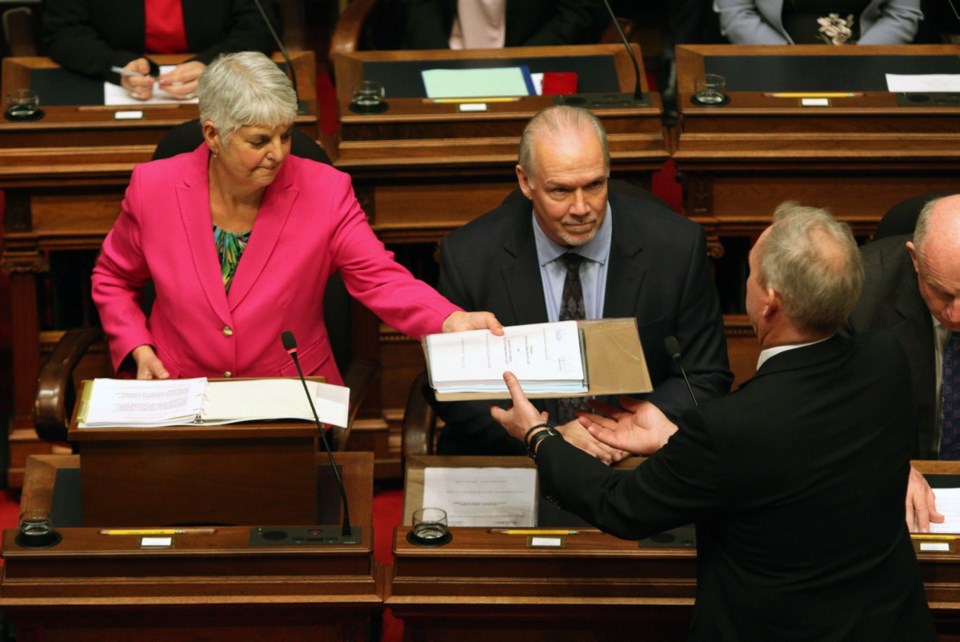Finance Minister Carole James is getting good at delivering balanced operating budgets. Her third one in a row unfolded at the legislature Tuesday and the game plan is to spend just a touch ($203 million) less than the government brings in.
There are some new moves that will be popular, but also a lot of “prudence” and hedged bets.
It’s on the capital spending side — the building of new infrastructure in all its forms — where she and the other cabinet ministers let their imaginations run free. Is there a bridge, hospital or school that the NDP government has turned thumbs down on?
Only one big one comes to mind — the Massey Tunnel replacement job. And even that is just paused, so they can erase the previous government’s fingerprints.
The NDP government is bound and determined to show it cares more about people than bottom lines. So even with a moderating economy, James’s operating budget — the annual spending plan — commits big money to improve programs and add some appealing new ones. James plans to spend right up to the balance point.
There is no such constraint on the capital side. If you need it or want it, borrow and build it. Paying for it comes much later.
It takes 15 dense pages to list all the projects planned or underway.
So Tuesday’s budget and three-year plan sets a record with a $32.6 billion outline to build schools, hospitals, power generation facilities and much more. About two-thirds of that — $22.9 billion is taxpayer-supported.
That means it’s paid off with taxes, not revenues from public commercial operations, such as B.C. Hydro.
That’s the record that was set, since it’s “the highest level ever,” the government was pleased to note. Liberals aimed for $13 billion in 2017 but lost power before they could do it.
There was no similar boast on Tuesday about debt incurred to pay for most of it. But there’s a new record there as well. No one has ever before planned to hike the provincial debt by $17 billion in three years.
Provincial debt, usually always on the rise, was at $38 billion when the economic meltdown began in 2008. The B.C. Liberal government followed everyone else in hiking infrastructure spending to ease the downturn that followed. So debt jumped to $65 billion over several years following the banking collapse.
It held at that range for a while, but is now climbing again under the NDP. It was $66 billion in 2018 and $70.6 billion this year (down slightly from the original forecast).
Starting this year the growth is scheduled to accelerate. Debt will reach $76 billion, then $82 billion and then $87 billion by 2022.
The gross number doesn’t mean much to people, but the metrics that relate it the economy are also on the upswing.
The debt-to-GDP ratio is going to jump almost three points, from 14.4 per cent to 17.1 per cent. The debt-to-revenue is going from 75 per cent to 94.4 per cent.
There isn’t a flicker of concern about any of these numbers from government.
James said debt remains affordable and B.C. is in an enviable position. She said rating agencies are comfortable with the level and tell her now is the right time to borrow. The interest bite is still only three cents on the dollar.
Even the Opposition is calm, complaining instead that government didn’t quite build as much as they borrowed for.
And the steady escalation to $87 billion is pretty much what the NDP outlined in their election platform, keyed on big infrastructure spending.
The “no worries” approach is fine as long as the economy keeps performing well and interest rates are stable. But former finance minister Mike de Jong, who had a similar approach to James on debt, told to a business crowd in 2017 that B.C. was nearing the limit on infrastructure spending.
The previous government was told by a rating agency that when debt-to-revenue reaches 92 per cent, they start thinking about downgrades.
So what happens when B.C. breezes past that in 2022 will be closely observed.d



